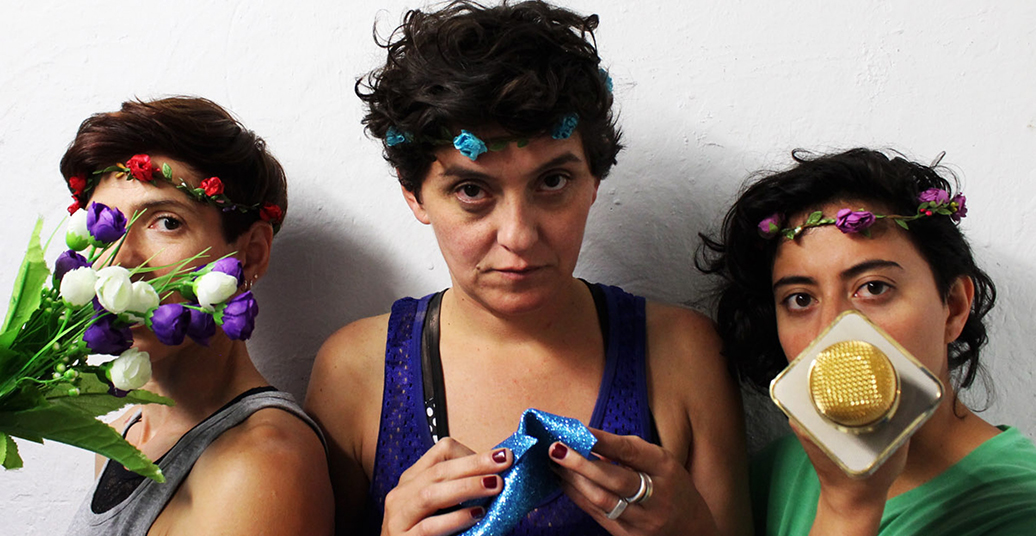In “Fan de Ellas”, premiering at Sophiensæle, Catalina Fernández, Juliana Piquero, and Alex Viteri dialogue with ‘three Latin American heroines’ through movement, soundscape, and objects.
The full moon shines as I cycle to the Sophiensæle. In the theatre lobby I find a fanzine made by the Fan de Ellas crew featuring the ‘three Latin American heroines’ – Gilda, Yulimar Rojas, and Luz Marina Giraldo Borda – to whom the performance is dedicated. It also features ‘other women that motivate us, inspire us, and that we like to have around us.’ As I dive into ‘Text in construction for stage Fan de Ellas’ the following words catch my attention.
Now I am mixing up memories that are not mine. I invent memories … I don’t think I’m saying much about you right now… I’m letting my mind run to see where it takes me.
I am reminded of a quote from Roberto Bolanõ’s short story, Clara, named after a woman the narrator once loved and who dies of cancer. After describing Clara for a page and a half in obsessive detail, the narrator pauses: ‘Anyway, what does it matter? All these details say more about me than they do about her.’ I feel something similar around what I witness in the performance.
Even though Juliana Piquero tells us that they have been researching these women for six months, we do not hear much verbal information about them. Instead, we experience personal interpretation and impersonation through movements, gestures, and sound. When the performers depict Yuliman Rojas, a triple jump world champion who set the second best distance in the history of the women’s triple jump (15.41 metres), they play out a physical and sonic reenactment of her imagined life. Piquero and Alex Viteri begin with slow and solemn gestures that simulate scenes of an athletic competition. The gestures grow into full movements that end in a victorious climax as Piquero enthusiastically throws flowers and Viteri marches, wrapped in a luscious pink fur cape. The sound of a cheering crowd, created live on stage by Catalina Fernández, swells in the background.
Such a literal approach might run the risk of appearing shallow, yet the extended duration of the sequence and the personality of the performers gradually diffuse a sense of poignancy. As the reenactment continues, I notice how hard the performers are working. Sweat soaks through their shirts leaving ever larger dark marks and their breathing intensifies, hinting not only at Rojas’s daily struggles and the discipline behind a glorious yet fleeting moment of success, but also the performers’ endeavour of reliving someone’s life as an act of mutual support in order to find a degree of joy. Through their embodiment of Rojas, I, in fact, see the performers themselves more clearly. I see Rojas as an inspiration viewed through their particular and distinct lens of sensibility.
I read the fanzine further, and another part jumps out at me: To tell you that when one loses hope it is like dying … ridiculous.
I immediately sympathise with this feeling in relation to losing a loved one. That vast void of sadness which drains the colours of hope into shades of grey. Is this still living? The sudden onslaught of very personal emotion when I read this line becomes clearer when Fernández reveals in the performance that one of the women, Luz Marina Giraldo Borda, is her mother. A rebellious and beaming spirit, she died from cancer in 2016. Today happens to be the three year anniversary of my uncle’s death. He passed away in 2016, as Fernández’s mother did. He was very dear to my heart and died in an accident. My body remembers this sorrowful time of year (just as my brain attempts to ignore it) by swelling and causing me pain.
‘Text in construction for stage Fan de Ellas’ is recited in Spanish (and projected on a screen in English) as the three performers rearrange objects on stage. Borda was ‘an expert in finding the perfect place to any type of object.’ Although this literal interpretation might again seem superficial, there is a kind of comfort to it. How does one deal with loss and sorrow? Mimicry is perhaps one way. My uncle used to eat instant noodles almost daily, and I remember my grandfather trying to do the same after his son’s death, but eating them only made him sick.
When one is inside the grey zone of sorrow, one often feels that there is nothing more to lose.
I ask again: How does one deal with loss and sorrow and find hope again? This attempt and process is demonstrated in Fan de Ellas. A long chunk of the performance sees the performers – first as a duet, then as a trio – following dance steps from a video they are watching on their phones. Since this comprises such a big part of the work, I run to the lighting booth after the show and ask the crew if they can tell me what that video is. They tell me that it is just a random YouTube clip that the performers chose for their studio practice and then decided to bring it into the performance. As they try to follow the dance video on their tiny screens, the performers look both clumsy and endearingly focused. It is a simple way of being together. Maybe it doesn’t matter what they actually do – the meaning lies in the fact that they do it together, over and over again, which creates solidarity, courage, and joy. And this, in my opinion, opens a possibility of slowly transforming the void of grief into a newfound space.
As I step out of the theatre and look up at the moon veiled behind dark clouds, I realise that whatever I write, it will end up saying more about me than the performance itself.




